The Majestic Legacy of Fatehpur Sikri: A Masterful Mughal City
Fatehpur Sikri is a hidden gem just 37 km (23 mi) southwest of the bustling city of Agra. This majestic town has a rich and intriguing history with roots tracing back to the Sikarwar Rajputs, a fierce subclan of warrior Rajputanas from North and Eastern India who controlled the area briefly at the end of the 12th century. They would be later ousted by the first of the Mughals, Babur, in the early 16th century. Although tourists flock to the famous Taj Mahal all year round, Fatehpur Sikri is a true diamond in the rough.
Inhabited since the Painted Grey Ware Period (1200 BC – 500 BC), this historic town rose to prominence under the rule of the Mughal Emperor Akbar the Great, who made it a part of his capital city in the 16th century. With its rich cultural heritage, Fatehpur Sikri is a true testament to the grandeur and opulence of the Mughal kings.
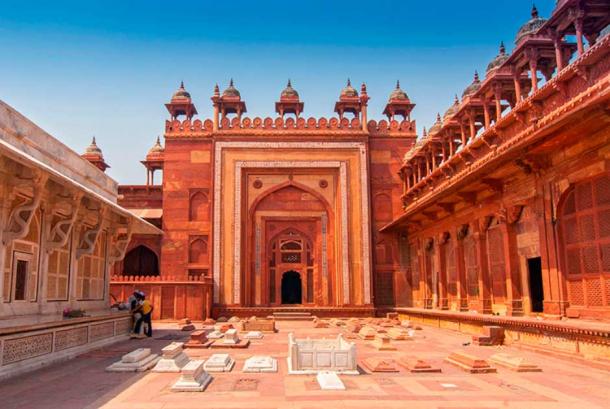
The abandoned Mogul city of Fatehpur Sikri in northern India. (Cezary Wojtkowski / Adobe Stock)
The Majestic Red Architecture of Fatehpur Sikri
Fatehpur Sikri served as the capital for a cumulative total of 14 years, before being abandoned entirely when it was shifted to Lahore in 1585. Much later, it was used by the British in India as a military outpost. Today, Fatehpur Sikri is renowned worldwide for its stunning red sandstone work and majestic red buildings that do not seem to have aged in over half a century.
- The Mughal Empire: Tolerance, Taxes, Addiction, Art, and Other Acts of Genghis Khan’s Relatives in India
- Controversial Mughal Emperor Aurangzeb & Mughal Wars of Succession
Architecturally significant, historians often point to the town planning of Fatehpur Sikri as a blueprint and evolution for Mughal town planning. Fatehpur Sikri was marked by magnificent administrative, religious, and residential quarters, with palaces, public buildings, mosques, and living quarters for the court, army and servants of the king, amongst others.
The same has been witnessed in the construction of Shahjahanabad, the walled city now known as Old Delhi (part of the larger metropolitan city of Delhi). Built under the reign of Shah Jahan (1628 to 1658), the walled city of Shahjahanabad contains the majestic Lal Qila (Red Fort) and the Jama Masjid (Arabic for “Friday Mosque”). Even after abandonment, it remained an area for temporary visits by subsequent Mughal emperors.
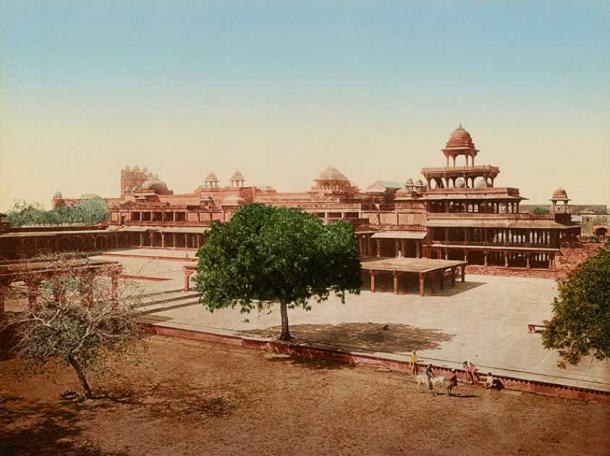
The Panch Mahal palace at Fatehpur Sikri in India. (Public domain)
The Tranquil Garden City of Fatehpur Sikri
Located on the banks of the River Yamuna, Fatehpur Sikri was a beacon of hope for the first Mughal emperor, Babur, and his son, Humayun. Its tranquil setting, away from the chaotic city of Agra, offered a safe haven and a chance to indulge in the Mughal's love of planned gardens.
The abundant water supply made it an ideal location for the imperial army to set up camp and the Mughals envisioned it as a lush, garden city where they could rest, relax and bask in the beauty of the northern plains. With its convenient location and picturesque surroundings, it's no wonder that Fatehpur Sikri quickly rose to prominence in the Mughal Empire.
Before it became known as Fatehpur Sikri, the village was simply referred to as Sikri up until the Sultanate period. This era lasted from 1206 to 1526 AD and was characterized by the rule of five heterogeneous Turkish empires in North India, formed by slaves from Central and Western Asia. These conquerors brought with them not only the practice of Islam but also a range of cultural elements, including cuisine, architecture, language, clothing and more, that had a profound impact on the social and political landscape of the Indian subcontinent.
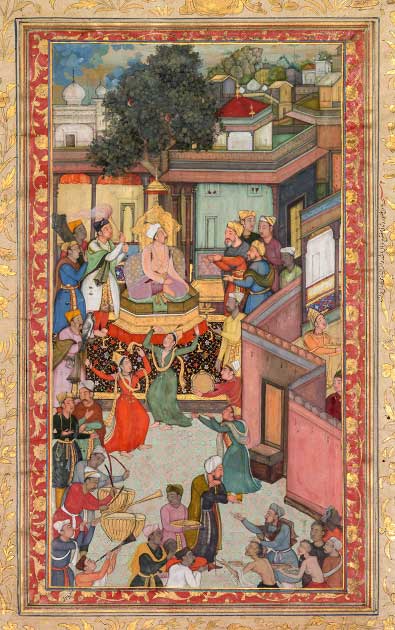
Depiction of the circumcision ceremony for Akbar's sons in his newly built capital city of Fatehpur Sikri. Dancers in Chaghatai Turkish dress perform as Akbar's weight in gold is being distributed to the poor. (Public domain)
The Growing Importance of Fatehpur Sikri
By this time, Sikri was under the control of administrators called hakims (literally “rulers”), from the Bayana region (modern-day Rajasthan). The construction of a mosque and tomb, as well as other residential and religious buildings, is recorded during this period, originating from the early 14th century under Allaudin Khilji.
Allaudin Khilji was a merciless leader of the Khilji Dynasty, the second Turkish slave dynasty to rule the Indian subcontinent from 1290 to 1320. He conquered vast areas of northern and eastern India, as well as made incursions into central and southern India.
- Urdubegis: The Forgotten Female Fighters of the Mughal Empire
- Princess Zeb-un-Nisa: Rebel Sufi Poetess and her Gilded Garden Prison
At this time, Sikri was an important Muslim settlement during the Khalji and Tughlaq periods, serving as an administrative center in the Bayana region. Later, Humayun, son of Babur, sought refuge from Sher Shah Sur in Sikri during his 1540 to 45 AD exile.
Sher Shah Sur, an Afghan Pashtun ruler and skilled administrator, displaced Humayun from the sub continental throne. In 1555, Humayun reclaimed the empire by defeating Islam Shah Sur, Sher Shah's son. Unfortunately, he died accidentally while falling from the steps of his library in Delhi in 1556, paving the way for his son, Akbar, to prematurely take over the throne.
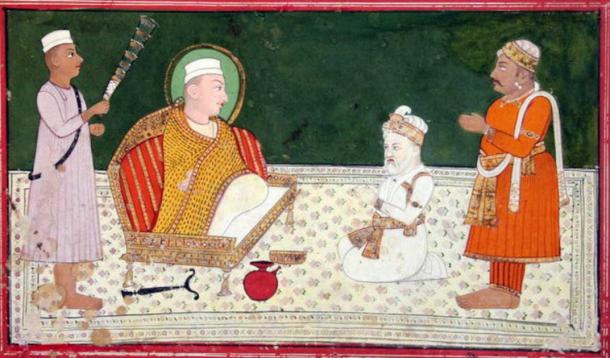
Shaikh Salím Chishtí with Mughal Emperor Akbar. (Public domain)
The Great Salim Chishti: Akbar’s Spiritual Mentor and Guide
One of Islam Shah Sur’s greater contributions was honoring the great Sufi saint, Salim Chishti, with the building of a khanqah or khangah at Fatehpur Sikri. This was a kind of state-sponsored housing project for Sufis, a religious order of Islamic ascetics and mystics.
Sheikh Salim Chishti, one of the famous Sufis of the Chishti order, came from the family of Baba Farid Ganj-e-Shakar of Punjab. The Chishti order, within the larger fold of Sufism, were renowned for their preaching of love, tolerance, and openness.
Born in Delhi, the young mystic Salim moved to Fatehpur Sikri with his father Sheikh Bahauddin, himself a famed Sufi of his times. Salim Chishti, incidentally, would bless Akbar with the birth of a son, coined Salim (later emperor Jahangir), when the Mughal emperor visited him and asked for his blessings.
Akbar had desperately been hoping for a male heir and over the course of 28 years had made several unsuccessful attempts with multiple wives in this venture. After visiting Sheikh Salim, Akbar would end up having three sons with the daughter of Raja of Amber, Man Singh I, of whom Salim was the first of the three, named in honor of the great saint.
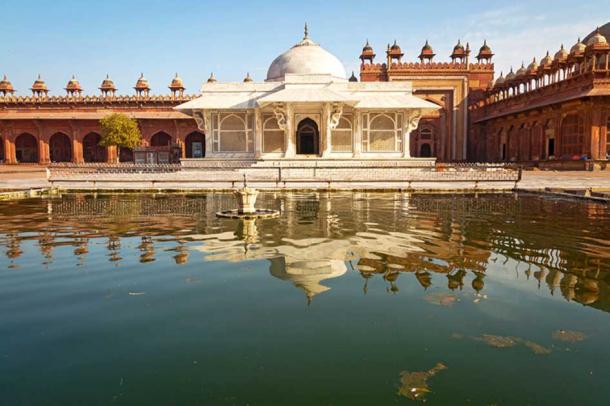
Salim Chishti tomb at Fatehpur Sikri. (Roop Dey / Adobe Stock)
Building a Khangah in Honor of Salim Chishti at Fatehpur Sikri
After the birth of Salim in 1569, Akbar made a thanksgiving pilgrimage to the dargahs (a term to denote a tomb or shrine of Sufi saints) of Khwaja Moinuddin Chishti at Ajmer and of Baba Farid at Pakpattan. He returned to Fatehpur Sikri after two years, ordering the construction of a new city adjacent to the khanqah of Sheikh Salim (the Sheikh would pass away in 1571).
Sheikh Salim’s khanqah housing project attracted the poorest of the poor, including the poor stonecutters of the area, who paid homage to him by building a small mosque around the cell where he performed his daily prayers.
Abul Fazl, Akbar’s court historian and grand vizier between 1579 and 1602, and author of the voluminous Ain-i-Akbari (in Persian), ranked Sheikh Salim as among those “who pay less attention to the external world but acquire vast knowledge and understand the mysteries of the heart.” Under the influence of Sheikh Salim Chishti, the Mughal emperor adopted the Chishti principle of sulh-e-kul, peace with all, as the official state policy.
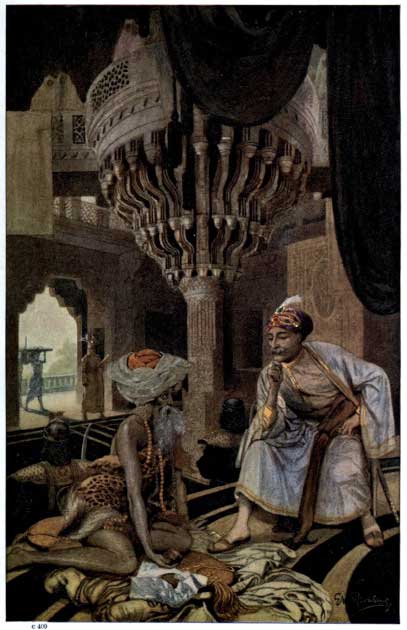
The great Mogul discoursing with a Humble Fakir by Sir Harry Hamilton Johnston. (Public domain)
The Architectural Organization of Fatehpur Sikri
At the heart of Fatehpur Sikri lies the free-standing square known as the Diwan-e-Khas (Hall of the Special), where the king would meet important dignitaries and emissaries. This was in contrast to the Diwan-e-Aam (literally meaning “the Hall of the Common Man”), where the king would hold audience with his people. The positioning of the Diwan-e-Khas in this courtyard was symbolic, meaning to emphasize Akbar as a universal ruler presiding over all people and religions.
The entire fortified structure at Fatehpur Sikri lies on an isolated, elevated, rocky ridge, from where the imperial city begins. On the northern front lies the Agra Gate (in the direction of the city of Agra), with a triple-arched gateway. Upon entering this gate lies the aforementioned Diwan-e-Aam, a large complex with galleries on all four sides. There is an imperial box in one gallery, designed especially for the emperor.
Upon crossing this, came Prince Salim’s quarters, residing very close to the emperor’s chambers. Crossing this is a beautiful red sandstone column with delicate carvings on three sides to form porticos around a small hall called the Daftar Khana or “the record room.” There is some dispute over this, as many contemporary scholars believes this is the Ibadat Khana or “the house of worship,” where Akbar would meet with priests and scholars of every religion.

Fatehpur Sikri near Agra in India.(Rechitan Sorin / Adobe Stock)
There is also a royal dining hall, with kitchens nearby, and cordoned off from the female quarters entirely. An exquisitely built seraglio known as Shabistan-i-Iqbal, the palace of Salim’s mother Mariam-uz-Zamani, has beautiful moldings and brackets all around. The emperor’s seven or eight main wives lived there, whilst the rest lived in the minor harem, with exclusive access from the emperor’s area, covered from any public scrutiny.
- The Mighty Red Fort of New Delhi, a Symbol of Mughal Power and Wealth
- Humayun's Tomb, the Mughal Mausoleum That Changed India’s Architecture
The imperial palace of the king was separated into two distinct zones: the private Daulat Khana-e-Khas (Residence for Royalty) and the public Daulat Khana-e-Aam (Residence for the Common Man). The private courtyard boasts breathtaking structures such as the Anup Talao (talao literally means lake), a magnificent pool, and the Panch Mahal, a five-story colonnaded rectangular building. The courtyard also features the intricately carved and decorated Turkish Sultana's room, officially known as the Hujra-i-Anup Talao, which was used by Akbar to receive guests.
Finally, the Jama Masjid, the earliest completed building on this summit of the ridge which incorporated the tomb of Sheikh Salim Chishti, received further embellishments under Jahangir in 1606. To the south of the court at Fatehpur Sikri lies the 40-meter-tall (131 ft) Buland Darwaza (the lofty gate), built to commemorate the victory at Gujarat in 1572. It remains one of Akbar’s finest monumental achievements till date
Top image: The Buland Darwaza, or High Gate, was built in 1602 as the main entrance to the Jama Masjid mosque at Fatehpur Sikri in India. Source: Shuklaankit90 / CC BY-SA 4.0
By Sahir Pandey
References
Dehlvi, S. 2015. Mystic Mantra: Sheikh Salim of Sikri. Available at: https://www.deccanchronicle.com/150520/commentary-op-ed/article/mystic-mantra-sheikh-salim-sikri.
Petersen, A. 2002. Dictionary of Islamic Architecture. Available at: https://books.google.co.in/books?id=9A-EAgAAQBAJ&source=gbs_navlinks_s.
Safvi, R. 2017. The secrets about Fatehpur Sikri. Available at: https://www.thehindu.com/opinion/columns/the-secrets-about-fatehpur-sikri/article21381895.ece.
Singh, S. 1995. THE ARCHITECTURE OF FATEHPUR SIKRI. Available at: https://core.ac.uk/download/pdf/144525062.pdf.



















